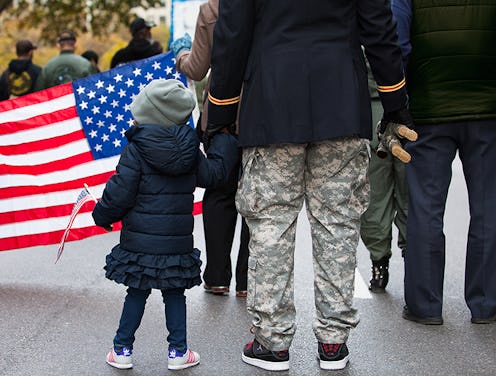Life
This Is What The American Dream Looks Like

Last Veterans Day, Queens-based photographer John Tona set out to capture stolen moments of New York City's annual Veterans Day Parade, where each year more than 600,000 spectators line the streets of New York City to honor all eras and branches of veteran military service and to salute those currently serving. Hosted by the United War Veterans Council, the traditional event begins with an opening ceremony and wreath laying at Madison Square Park's Eternal Light Monument on 24th Street, then continues to march 1.3 miles north up New York's iconic Fifth Avenue, concluding at 52nd Street.
Providing the opportunity to tell veterans' stories on our nation's largest stage, the annual procession is meant to remind Americans of the service and sacrifice of those who have defended our national freedoms. But for Tona, what started as a veteran-focused project quickly turned into a chronicling of the parade's observers. As he captured the faces of civilian men, women, and children, he couldn't help but see a small part of himself in each fleeting expression. These observers, these patriots, he thought, gathered here to celebrate something larger than themselves — a deep-seated ideology our country embodies and a right our military defends. Our mere participation year after year says something about our dedication to that prolific idea of the "American dream."
As famed historian Richard Hofstadter once wrote, "It has been our fate as a nation not to have ideologies, but to be one."
And yet, this American dream differs for each person. As Tona returned home from the parade and scrolled through the images one by one, he came to realize the emotional necessity of his budding project. People of all ages and backgrounds were paying tribute to the American dream — the same dream he had pursued himself. His photos revealed countless onlookers reacting to a shared ideology in a variety of ways — young boys dressed in dreams; an elderly widow recounting 60 years of marriage; fresh cadets eager to make change; and the father who still believed in the fight, even after losing his son in battle. Brief backgrounds surmised by expressions, in that moment, were his version of Americans.
As a friend and former colleague, I had the pleasure of brainstorming titles for this project and reworking the abstract alongside Tona. Drawing upon the influences of Swiss-born photographer Robert Frank and American playwright Arthur Miller, Tona's portfolio took final form. Interestingly enough, an Amtrak-induced text banter originating in Washington, DC produced its apt title: The American Meme, Heirs To An Illusion.
With another Veterans Day upon us, Tona's project immediately sprang to mind this year. What does the "American dream" look like today, one year after he started his photo series? How has an endless stream of information shaped the way we see the American dream? How has it morphed and molded into something different, into an American meme, a part of our culture that's continually passed around and added to? Perhaps the beauty of our deep-rooted ideology is that it allows its civilians to do exactly that — continually reinvent ourselves. For me, word by word, and for Tona, image by image.
Tona continues to explore these questions in his work. The artist currently teaches photography at New York Film Academy, and is slated to display his portfolio "The American Meme" in the December 2014 Seoul, Korea-based exhibition titled, Birth, where artists are asked to depict the question, "Is life active or passive?" His full body of work can be found on his website.
Images: John Tona (5)